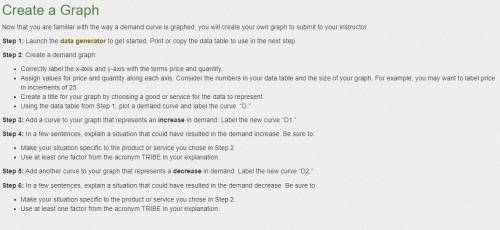
Business, 20.08.2020 01:01 yayamcneal05
Heyyy pllz help will mark Brainliest!! Step 2: Create a demand graph: Correctly label the x-axis and y-axis with the terms price and quantity. Assign values for price and quantity along each axis. Consider the numbers in your data table and the size of your graph. For example, you may want to label price in increments of 25. Create a title for your graph by choosing a good or service for the data to represent. Using the data table from Step 1, plot a demand curve, and label the curve “D.” Step 3: Add a curve to your graph that represents an increase in demand. Label the new curve “D1.” Step 4: In a few sentences, explain a situation that could have resulted in the demand increase. Be sure to: Make your situation specific to the product or service you chose in Step 2. Use at least one factor from the acronym TRIBE in your explanation. Step 5: Add another curve to your graph that represents a decrease in demand. Label the new curve “D2.” Step 6: In a few sentences, explain a situation that could have resulted in the demand decrease. Be sure to: Make your situation specific to the product or service you chose in Step 2. Use at least one factor from the acronym TRIBE in your explanation.


Answers: 1
Another question on Business

Business, 21.06.2019 22:10
Fess receives wages totaling $74,500 and has net earnings from self-employment amounting to $71,300. in determining her taxable self-employment income for the oasdi tax, how much of her net self-employment earnings must fess count? a. $74,500 b. $71,300 c. $53,900 d. $127,200 e. none of the above.
Answers: 3

Business, 22.06.2019 08:00
At a student café, there are equal numbers of two types of customers with the following values. the café owner cannot distinguish between the two types of students because many students without early classes arrive early anyway (i.e., she cannot price-discriminate). students with early classes students without early classes coffee 70 60 banana 51 101 the marginal cost of coffee is 10 and the marginal cost of a banana is 40. the café owner is considering three pricing strategies: 1. mixed bundling: price bundle of coffee and a banana for 161, or just a coffee for 70. 2. price separately: offer coffee at 60, price a banana at 101. 3. bundle only: coffee and a banana for 121. do not offer goods separately. assume that if the price of an item or bundle is no more than exactly equal to a student's willingness to pay, then the student will purchase the item or bundle. for simplicity, assume there is just one student with an early class, and one student without an early class. price strategy revenue from pricing strategy cost from pricing strategy profit from pricing strategy 1. mixed bundling $ $ $ 2. price separately $ $ $ 3. bundle only $ $ $ pricing strategy yields the highest profit for the café owner.
Answers: 1

Business, 22.06.2019 20:00
Question 6 of 102 pointswhich situation shows a constant rate of change? oa. the number of tickets sold compared with the number of minutesbefore a football gameob. the height of a bird over timeoc. the cost of a bunch of grapes compared with its weightod. the outside temperature compared with the time of day
Answers: 1

Business, 22.06.2019 23:10
The direct labor budget of yuvwell corporation for the upcoming fiscal year contains the following details concerning budgeted direct labor-hours: 1st quarter 2nd quarter 3rd quarter 4th quarterbudgeted direct labor-hours 11,200 9,800 10,100 10,900the company uses direct labor-hours as its overhead allocation base. the variable portion of its predetermined manufacturing overhead rate is $6.00 per direct labor-hour and its total fixed manufacturing overhead is $80,000 per quarter. the only noncash item included in fixed manufacturing overhead is depreciation, which is $20,000 per quarter.required: 1. prepare the company’s manufacturing overhead budget for the upcoming fiscal year.2. compute the company’s predetermined overhead rate (including both variable and fixed manufacturing overhead) for the upcoming fiscal year.
Answers: 3
You know the right answer?
Heyyy pllz help will mark Brainliest!! Step 2: Create a demand graph: Correctly label the x-axis and...
Questions










Chemistry, 24.07.2020 20:01


Chemistry, 24.07.2020 20:01








Mathematics, 24.07.2020 20:01



